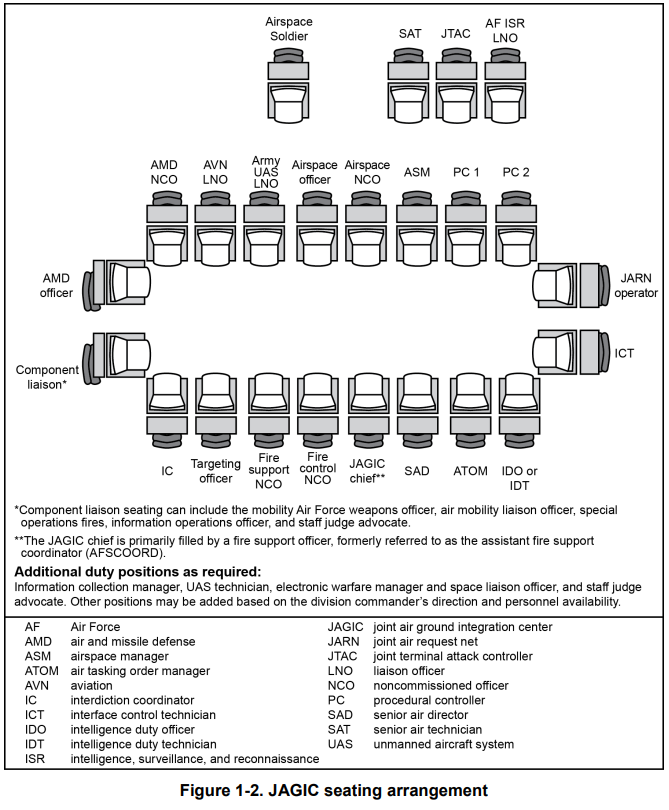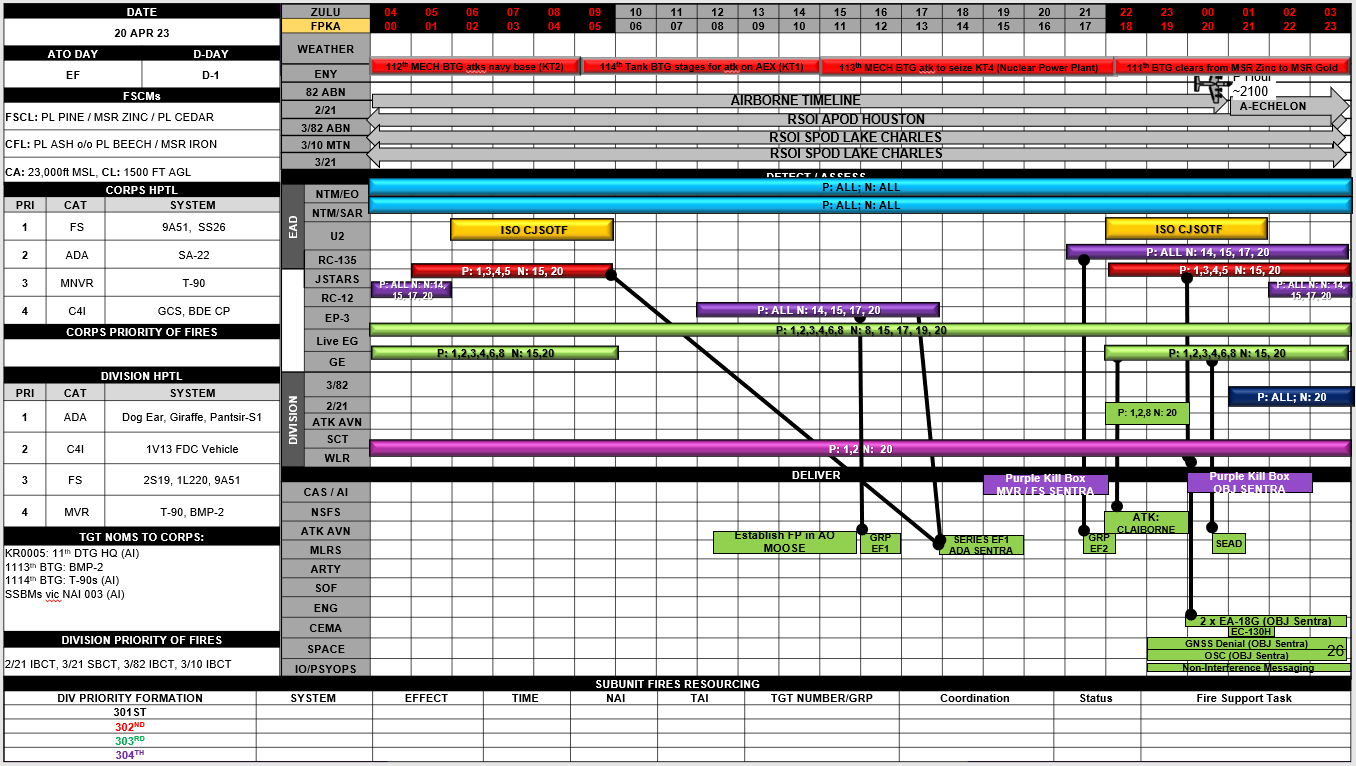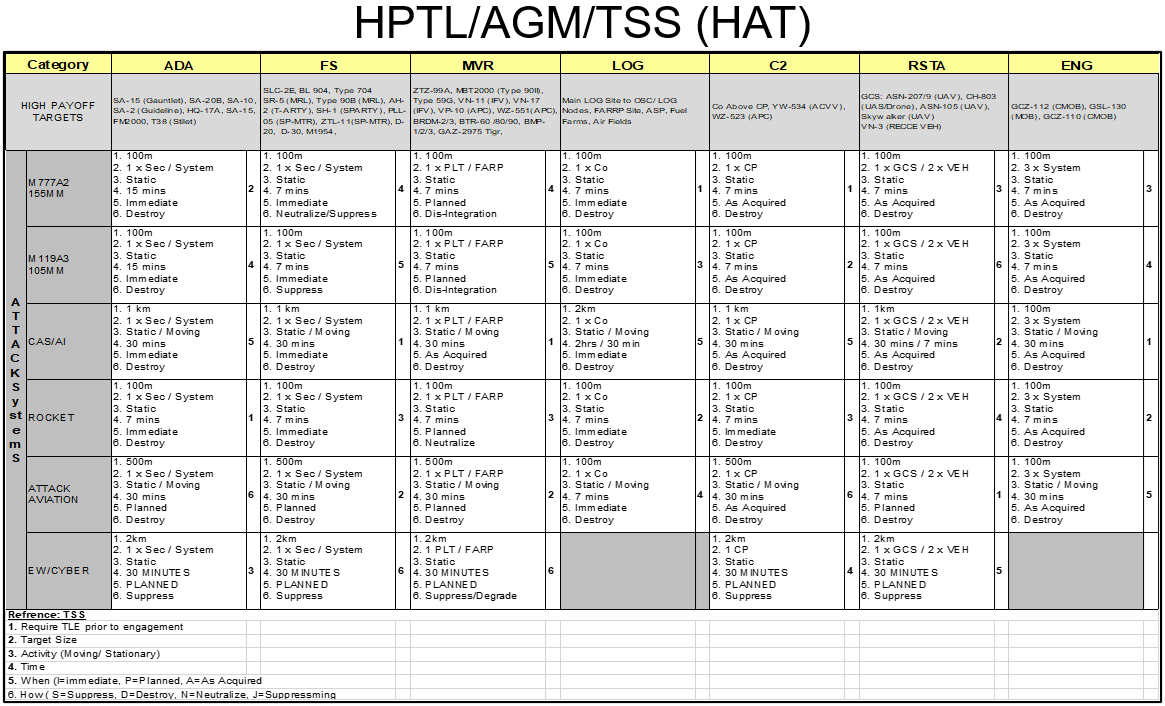JAGIC – An All American Perspective
From December 2023 to August 2024, the 82d Airborne Division served as a
rotational division headquarters in Europe. One of the priority efforts during the rotation
was Security Force Assistance (SFA) to NATO allies. The division Fire Support Element
(FSE) trained Joint Air Ground Integration Center (JAGIC) operations and targeting with
eight division-level or higher headquarters from four different nations.
The FSE noted three main obstacles to successfully implementing JAGICs. The
first obstacle, which underpins the other two, is a general misunderstanding of the
JAGIC and its role within the division staff and command post. The second obstacle is
the relationship between the division’s targeting process and the JAGIC. The third
obstacle is training a JAGIC to perform its functions.
Comparing training with international allies over the rotation to training internal to
the 82d Airborne Division over the last couple years, the FSE realized these obstacles
are not unique to NATO allies. Many U.S. leaders new to our divisions’ staffs also
misunderstand the JAGIC. The purpose of this article is to provide an overview of the
JAGIC to leaders unfamiliar with the JAGIC, whether they are U.S. or allies, fires or
another Warfighting Function (WfF). To better understand JAGICs, the FSE offers an
82d Airborne Division perspective on defining the JAGIC, the relationship between the
JAGIC and the Targeting process, and an approach to training the JAGIC.
Defining the JAGIC
The simplest explanation of a JAGIC is a seating arrangement to collocate the
people and systems responsible for Current Operations (CUOPS) air-ground integration in order to make the process more efficient. As one senior leader describes it, the JAGIC is the core of the division’s Current Operation Integration Cell (COIC) and serves as the “killing machine” for the division.
ATP 3-91.1/AFTTP 3-2.86 The Joint Air Ground Integration Center provides a
doctrinal definition of the JAGIC; “Located in the Army division COIC, the JAGIC
provides commanders a technique to coordinate, integrate, and control operations in
division-assigned airspace and efficiently collaborate requirements with external
airspace elements outside of the division area.”
In addition to simplifying definitions of the JAGIC, it is also helpful to describe
what the JAGIC is and is not.
What a JAGIC is:
The concept of JAGIC operations has been trained and practiced in the U.S.
Army for over a decade and is an established part of our doctrine. Our structure,
manning, and habit of joint operations have enabled the JAGIC to be highly
customizable and fluid from organization to organization. It is the arrangement of joint
personnel who have been empowered to make decisions and execute both deliberate
and dynamic targets throughout the division’s area of operations. Because of the high
tempo and breadth across multiple domains of operations inherent in large scale
combat operations, this arrangement allows for the JAGIC chief and the Chief of
Operations (CHOPS) to readily access information from each of the functional cells to
quickly and effectively identify targets, deconflict maneuver units and airspace, and
execute fires. The manning, structure, and proclivity for joint operations is something
that is not ubiquitous among our allies/partners and presents a major hurdle to be
overcome in the implementation of a JAGIC in these organizations.
The unique capabilities that help make the JAGIC so effective are the presence
of a Field Artillery Intelligence Officer (FAIO) in the Analysis and Control Element (ACE)
and the collocation of the Air Support Operations Center (ASOC) in the COIC. The
presence of a FAIO enables real-time analysis of battlefield intelligence, identification of
high-value targets, and recommended targeting solutions in order to rapidly respond to
emerging threats and exploit enemy vulnerabilities. The ASOCs presence in the COIC
is integral to coordination of large numbers of Air Interdiction (AI), Close Air Support
(CAS) missions, and Airspace Control which are necessary in a large scale, multi-
domain operational environment.
What a JAGIC is not:
Two common pitfalls the FSE observed in the implementation of JAGICs are the
lack of appropriate functional area personnel and the lack of distinct and separate plans,
FUOPS, and CUOPS. The JAGIC is not solely a Field Artillery cell. It requires
empowered personnel from each component in the Area of Operations; without
constant representation from Intelligence, ground maneuver units, Air Force, Army
Aviation, Air Missile Defense and appropriate Liaison Officers, the Cell is neither joint
nor able to effectively integrate capabilities.
The JAGIC is also not FUOPS, and in general, the personnel in the JAGIC
should not be involved in planning efforts. The tempo and duration of operations
anticipated in future large-scale conflict require separate groups of people working
simultaneously in the JAGIC/CUOPS, Targeting/FUOPS, and plans.
At the division level, the JAGIC and CUOPS should focus on operations within the next 24 hours,
FUOPS and the targeting process should focus on operations between 24 and 96
hours, and plans should focus efforts on 120+ hours. JAGIC personnel cannot routinely
leave the JAGIC to work on planning or participate in the targeting process without
degrading the JAGIC’s ability to quickly, effectively, and efficiently execute the fires plan
and conduct dynamic targeting.
Targeting Process and the JAGIC:
The allure of a JAGIC is its ability to rapidly prosecute fires across the unit’s
operational area. However, that is enabled by days of planning and preparation.
Numerous processes are required before actually firing a weapon. Deliberate targeting
is a methodical approach to planning lethal and non-lethal fires to meet the
commander’s intent. Unseen to the JAGIC are the proposals and decisions made by
staffs and commanders prior to execution in CUOPS. A JAGIC executes the decisions
already made by the commander during the Target Coordination Board (TCB). The
decisions made by JAGIC leaders must be within the commander’s guidance and intent.
The 82d ABN DIV FSE identified three aspects of the Targeting Process that are
vitally important to its relationship with the JAGIC. First, targeting is a whole of staff
approach; only if all WfF are represented in the targeting process can the JAGIC
effectively synchronize the execution of CUOPS. Second, the targeting process must
produce detailed but usable fighting products for the JAGIC. Lastly, the JAGIC can only
execute the plan if they receive and understand the plan in an effective FUOPS to
CUOPS transition.
Whole of staff approach:
Targeting is a ‘whole of staff’ approach and is doctrinally one of the staff
integrating processes of Army headquarters. Primary contributors are Intelligence,
Fires, and Plans, but targeting is still reliant on the other functions and staff sections
including logistics, assessments, weather, protection, legal, etc. Put simply, Plans
provides the objectives to be achieved (locations, timing, battlefield geometry),
Intelligence estimates what the enemy will do, and Fires attacks prioritized targets in
windows of opportunity. Many ancillary functions must be accounted for to enable
targeting. Limited numbers of UAVs (Unmanned Aerial Vehicles) must be scheduled,
prepared, flown, and their operators must know what they are looking for. UAVs require
airspace to fly in, as do surface-to-surface rockets; airspace planning is a key enabler to
targeting. The legal section must ensure that the plan and execution are appropriate as
there are restrictions on target engagements at national, theater, and higher echelons.
Getting rocket and cannon batteries in range requires travel time, fuel, and the
appropriate munitions to be loaded. The examples are effectively endless; the point is
that nearly all functions represented in a division or above level staff have at least an
ancillary role that enables targeting and so must be represented during targeting.
Fighting products:
A commander approved plan is the product of deliberate targeting which must be
accurately and concisely handed off to current operations, the JAGIC, to be
implemented. Four key products contain the plan and have enough flexibility to adapt to
changing personnel and the operational environment. First and foremost, the Target
Synchronization Matrix (TSM), followed by High Payoff Target List-Attack Guidance
Matrix-Target Selection Standards (HAT), the Target List Worksheet (TLWS), and battlefield geometries including Fire Support Coordination Measures (FSCM). The TSM
is premier since it correlates scheduled assets, anticipated events, forecast weather,
and templated enemy actions. It also states key info such as priorities of fire, in-effect
FSCMs, higher headquarters’ priorities, and approved target sets all for rapid reference.
No other document displays all these key aspects in time. The HAT is a rubric for
verifying a potential target meets the commander’s intent and includes what constitutes
a target, what to attack targets with, and what effect to achieve against the target.
FSCMs are often relayed via digital graphic overlays but can be summarized in
paragraph form. Current active measures, their locations, and the triggers approved to
change them are the key information for FSCMs. Last, the TLWS consolidates as much
technical detail as is available up to the FUOPs to JAGIC handoff.
FUOPs to CUOPs Transition:
Largely, CUOPs/JAGIC personnel are not part of the deliberate targeting process
and so handoff efficacy is paramount. Writing and understanding the above products
the same way is required. The FAIO is often the liaison from deliberate to dynamic since
they assist intelligence and collection to support planning, understand the Course of
Action (COA) developed, and finally actively vet potential targets during execution. The
FAIO generally cannot take the time to explain for each person in the JAGIC but can
steer efforts by vetting targets and be active during CUOPs. The JAGIC chief ultimately
must understand the intent and scheduled assets for the next 24-hour period.
Successful techniques include a deliberate brief/handoff from planners, the JAGIC chief
“back-briefing” just the next Air Tasking Order (ATO) day during the commander’s
approval, and remotely monitoring the target coordination board as they occur.
How To Train The JAGIC:
Once units understand the JAGIC and how it relates to the targeting process, they
can begin to train their JAGICs. Three key points the 82d JAGIC discovered about
training JAGICs are the necessity for SOPs, a doctrinally grounded progressive training
strategy, and training that reinforces the JAGIC as a part of teams of teams.
Build, Use, and Refine SOP Good units have updated Standing Operating Procedures (SOPs). Great units use them. JAGICs must build, use, and refine SOPs tailored to how their current team will
accomplish their mission. Every unit has unique personnel strengths and weaknesses,
and manning and equipment constraints. NATO organizations and national divisions are
all organized differently and thus struggle to adhere to the same base doctrine. The best
units build their SOPs and task organize to accomplish the functions of the JAGIC
instead of strictly adhering to the prescriptive manning, layout, and seating
arrangements of ATP 3-91.1. JAGIC SOPs must also be nested with division SOPs and address how the JAGIC
will interact with other cells including the COIC, ACE, Division Artillery (DIVARTY),
Targeting and Future Operations (FUOPS) cells. Tactics, Techniques, and Procedures
(TTPs) and equipment change rapidly, so JAGICs must review and validate or refine
their SOPs frequently.
Training Strategy:
TC 6-0.4 Training the Mission Command Warfighting Function for Divisions and
Corps (April 2019) provides a progressive strategy for training staffs and command
posts (CPs). As a part of the division’s CP, JAGIC leaders must nest within this doctrine
and their commander’s guidance for training. Begin by training individuals on their
duties and responsibilities. C2 and digital systems operators are vitally important in
initial training. Next, train the JAGIC on basic collective tasks such as the battle drills to
coordinate surface-to-surface, air-to-surface, and surface-to-air engagements. Once the
individuals in the JAGIC are proficient and the JAGIC as a whole understands its
internal processes, JAGIC must train as a component of the division and division’s CP,
incorporating the rest of the COIC, ACE, DIVARTY, Targeting, FUOPS, etc.
Part of a team of teams:
The JAGIC cannot do its job in isolation, and thus should not be trained in isolation.
At a minimum, it requires a robust (if not complete) scenario with battlefield framework
and targeting outputs. Even when training alone, there must be external stimulation to
provide targetable intelligence data (TIDATS) and interaction with subordinate units and
delivery assets (DIVARTY, CAB, CAS/AI, AAA, ADA, SOF, etc.).
Conclusions:
During their nine-month rotation to Europe, the 82d ABN DIV FSE trained with eight
division-level or higher headquarters from four different nations. This training focused on
targeting processes and implementing JAGICs. The FSE identified three main obstacles
to successfully implementing JAGICs: defining the JAGIC, linking targeting to the
JAGIC, and effectively training a JAGIC and JAGIC personnel. These obstacles are not
unique to our allies and exist as obstacles to implementing JAGIC in U.S. Army
Divisions.
To successfully implement a JAGIC, division leaders and JAGIC personnel must first
understand what a JAGIC is (colocation of CUOPS fires, AMD, aviation, and ASOC
personnel) and understand what it is not (planners, FUOPS, or deliberating targeting).
They must also be able to link JAGIC execution to deliberate targeting outputs through
an efficient and effective FUOPS to CUOPS transition. Finally, they must train the
JAGIC and JAGIC personnel as an integrated component to the rest of the division staff
and CP.
About the authors:
MAJ Thompson is a BCT FSO in the 82d ABN DIV. His previous assignments include
JAGIC Chief, FSO and BTRY OCT at JRTC, BTRY Commander and SQDN FDO in 3d
CR, and BN FSO, Co FSO, PL, and PLT FDO in the 101 st ABN DIV (AASLT).
CW3 Toulouse is a Targeting Officer in the 82d ABN DIV, DIV FSE. His previous
assignments include DIVARTY Targeting Officer and BCT Targeting Officer in the 82d
ABN DIV, and BCT FAIO and BCT Counter Fire Officer in the 1 st CAV DIV.
CPT Wakefield is a Fires Planning Officer in the 82d ABN DIV, DIV FSE. His previous
assignments include BN S2 and HHB Commander in 1-113 th FA, 30 th BCT. BN FSO 4-
118 th IN, Co FSO, PLT FDO, PL 1-113 th FA, Ass. Effects Coord 1-124 IN, 53 rd BCT.
CW2 Kraft serves as a Brigade Counter Fire Officer in the 82d ABN DIV and previously
served as a Targeting Officer in the 82d ABN DIV, DIV FSE. He served 11 years as a
13F, performing duties in every position from PLT FO through BCT FSNCO in
conventional and SOF units.
